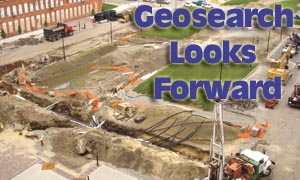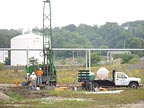
Staying on the leading edge of any industry requires keen foresight and a heart-felt commitment, along with the ability to be flexible when necessary. Environmental drilling contractor Geosearch Inc., Fitchburg, Mass., goes about its business armed with a boatload-and-a-half of each of those essential attributes.
The company traces its beginnings to 1989. “While going to the University of Massachusetts, I worked for a drilling company between semesters,” recalls Geosearch president Matt Bovenzi. “My background before that was construction, so I really enjoyed it; drilling was a natural fit. After leaving school, I started Geosearch in the fall of 1989. I hired a driller - I started out as the assistant driller - and we kept growing from there. We hired an office manager, Martin Secino, while I stayed in the field. Then Tom Belsky came on board as a lead driller. Tom and I went for a few years together and we've been growing the company since then.”
Today, the company boasts 50 employees (18-20 crews) and a fleet of 18 auger rigs, seven Geoprobes and four vacuum units. All maintenance is done in-house at Geosearch's new facility, which was designed to be able to house most of the firm's equipment inside, away from the often-harsh weather conditions of the area. “We want the guys in the field to have an easier time getting their days started,” Bovenzi explains.
The company is comprised of three divisions: “Environmental drilling comprises about 70 percent of our business, with clean water and construction making up the other 30 percent,” Bovenzi explains. “We added clean water in 2001, so that's kind of new for us. Before that, it was strictly environmental drilling and environmental construction. Construction always has been about 20 percent.”
Further explaining Geosearch's growth up until now, Bovenzi says, “From 1989 to 1991, we had one rig. After that, we steadily added a rig at a time - until the direct-push technology entered the picture. When it was new, people were skeptical as to whether or not it would work, but we jumped on it right away.” That allowed for a more pronounced growth spurt. Another was soon to follow. “In 2002, we purchased Environmental Drilling Inc. That increased the size of the company 25 percent. We brought over pretty much all of their employees and sold their building. Their former owner still is with us. It was a really good experience successfully merging one company into another. We still have separate offices, but as far as field personnel is concerned, it's pretty much all one company now.”
Even though the company has three distinct divisions, all Geosearch employees are prepared to work wherever they're needed. Cross-training provides this flexibility. “We might go a week where all the work is environmental,” notes Bovenzi. “Then the next week, there might be more construction work. So our crews are interchangeable. While some employees specialize in one area or another, they're all capable of jumping over to wherever the demand is. Our turnover rate is unusually low, I think. A lot of the original people that I started with my first three or four years in business still are here. We've avoided a lot of problems I've seen other contractors have, and that makes growing the company that much easier.”

Markets Served
"Our clientele up until 2002 primarily was petroleum and chemical concerns - the lion's share of which was work at gas stations and airports,” says Bovenzi. “We'd do the environmental site investigations. Not only do we do the drilling, we also do the trenching and the pipe laying for the engineers. It's one-stop shopping at that point. Environmental's clientele was more government and geotechnical projects. So, with different backgrounds and different client bases, we found a good complement to what we were doing, and it's worked out really well.“Our market is New England in general, but we've been as far as Pennsylvania, Ohio and Florida. Depending on what the project is, if the numbers work, we'll go anywhere. Looking back at our first year of business and the clients we had then - the majority still are our clients. Our client base probably is relatively small - under 15 companies. After years of working with them, they know how we operate and they know that we can adapt as they evolve themselves. That part of it has worked out really well.
Asked if Geosearch is targeting any new markets, Bovenzi replies, “We're looking at geothermal a lot - it's an ingenious technology. It hasn't really taken off full-tilt in New England yet and we want to be on the leading edge when that does come up in the near future. Clean water is a market that's been around certainly, but it's new to us. With our background in environmental, we're approved on a lot of levels with the state and that helps us with some of the larger-scale projects.”
As much as Geosearch wants to stay in the forefront when it comes to new technologies, Bovenzi does so with a sense of discipline. “There's a fine line when it comes to the amount of research and development you do. Too much can hurt you, but if you do it enough that you can stay on top of new technologies, it will pay off.” Bovenzi points to the flute system as an example. “That's going to be a strong environmental tool,” he asserts. “If you're one of the first to understand how the application works, you'll be able to take advantage. It's a reversible sock, and after you core the hole, you put in the sock for different sampling ports and do your tests. On the few jobs we've used it, it's been quite impressive as to the amount of information you can gain.
“On these types of new technologies that are coming out, if you can get the jump on it and understand it, you'll attract clients. We have people calling us asking about the best way to handle certain types of projects and get the information they need. Our service can go a lot further than just showing up with an auger rig and doing things just one way.”
Commenting on Geosearch's marketing strategies, Bovenzi says, “We weren't strong in marketing - nothing more than t-shirts - until 2002, when John Stamas, director of marketing, came on board. In Massachusetts, there still are many potential clients who don't even know we're in business so we know that there are plenty of people to market to. We don't do a lot of mailings. We concentrate on researching companies we think we might be able to serve. If I can add one client a year, I'm happy. It's an everyday thing; we don't wait for things to slow down before we act.”

Hurdles to Face
Asked about the major issues facing his company, Bovenzi immediately says, “Insurance costs: That's the biggest bill in the company. There are certain insurance restrictions right now that are becoming very prohibitive to be able to make things work financially. Hopefully, that ends up getting under control cost-wise. As far as the industry is concerned though, what's important is having quality equipment and seasoned employees who understand that safety is the No. 1 goal, along with quality work.
“Here in Massachusetts, the regulatory agencies are well structured. The biggest thing is with the individual towns with their varying bylaws. But we've been around long enough that when a job comes up, we just punch it up and we know exactly what we need to do. Every town is a little different but we have a pretty good database and we know how each town operates - and how we have to operate in each town. And the engineering firms handle a lot of the red tape before it even gets to us. And it's the same state-to-state in New England - while there are some differences, overall, things are pretty much the same. It just comes down to having the experience and doing it.”
Today's Marketplace
“Around here, if you're booked out 10 days, that's really good,” stresses Bovenzi. “Right now, we're scheduled out a month. We have more equipment than we book out, so even in a pinch, if a client needs something right away, we can get it done.” And Geosearch's office staff - which all came from the field - can jump in as well. “Say we're actively trying to schedule 20 rigs, we probably could run 25 if we had to. While most of our jobs are one- to five-day shots, our environmental drilling division typically will secure a two-month job, so there are some things that are further out. But just because we have a few rigs scheduled, we don't consider that time period booked yet. When you start booking out too far in advance, the changes end up being so dramatic, it's hard to keep track. Everything's down to the penny, every day counts; a bad day can affect you for a long time.“A good 80 percent of our work still is bid - and it's a very competitive industry out here; there are a lot of excellent companies that we compete against.” Where Geosearch is situated, there are 10 to 12 drilling firms within a 20-mile radius. “One of the nice things about the industry out here is that everybody - at one time or another - worked either together or knows some of the people who have worked together,” Bovenzi explains. “It's a friendly, fun competition.” Outside competition? “There hasn't been a start-up here in 10 years.”
And to what does Bovenzi attribute his firm's success? “The best employees and the best customers and the best support from your family - that's what makes it work.”
ND
Report Abusive Comment